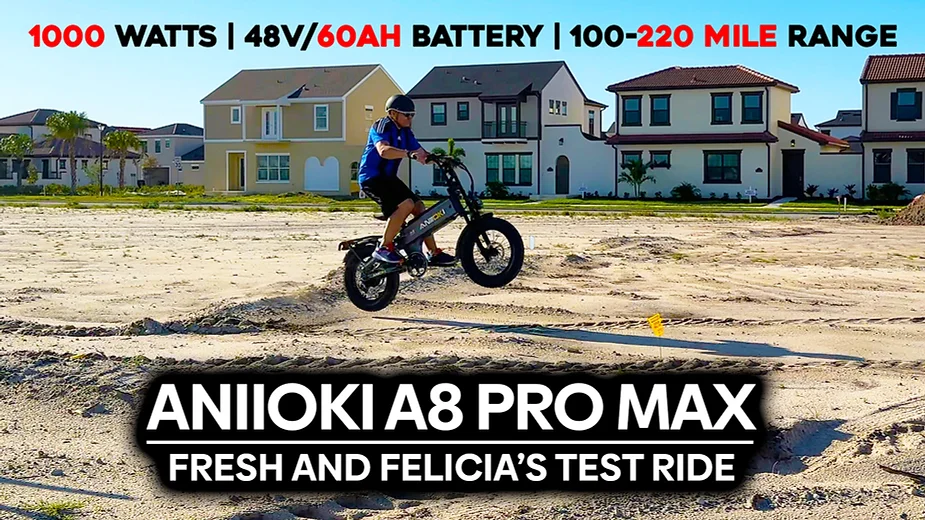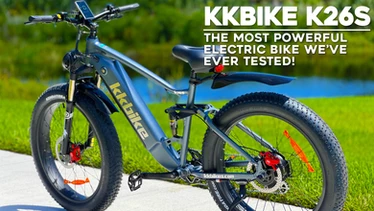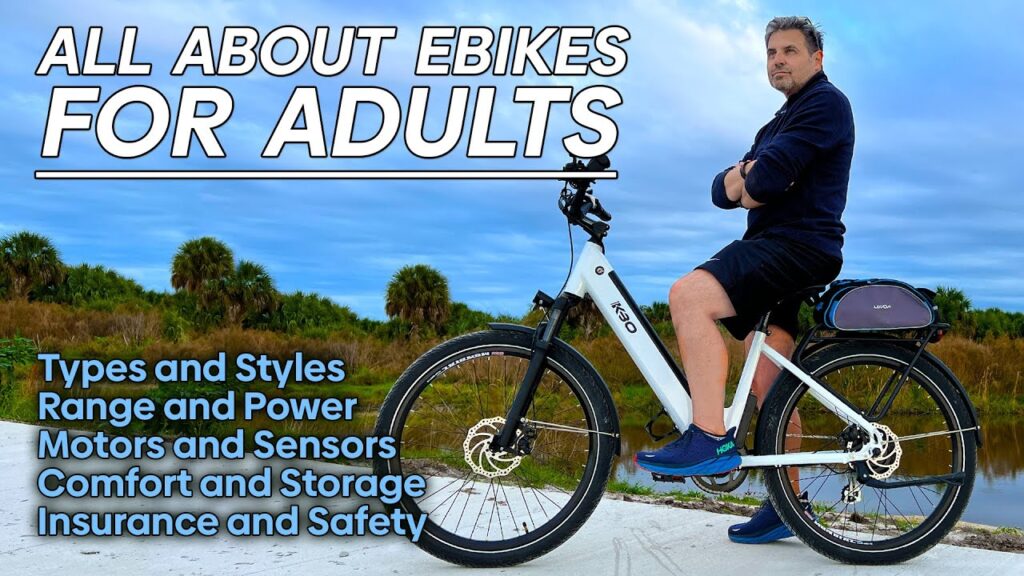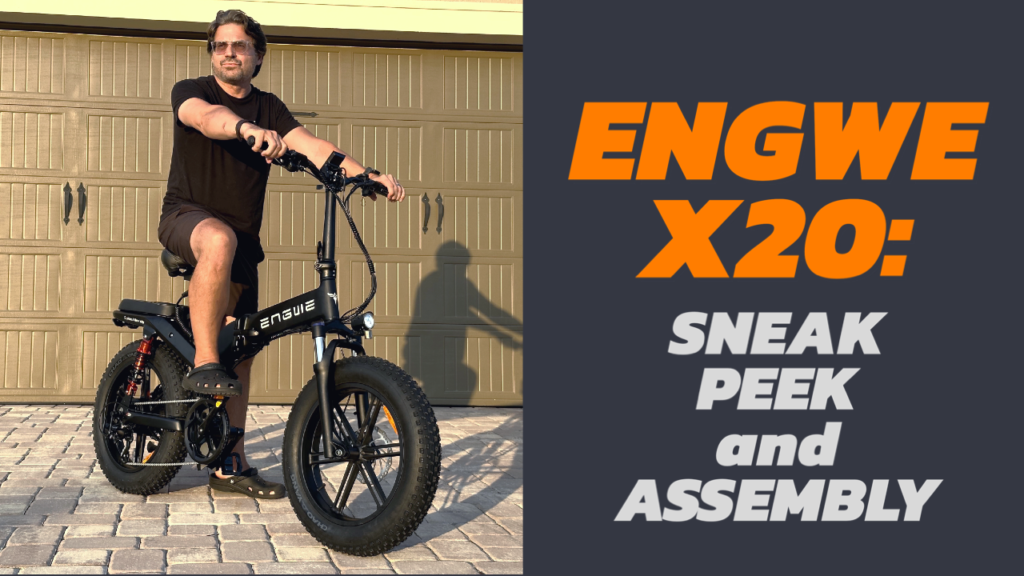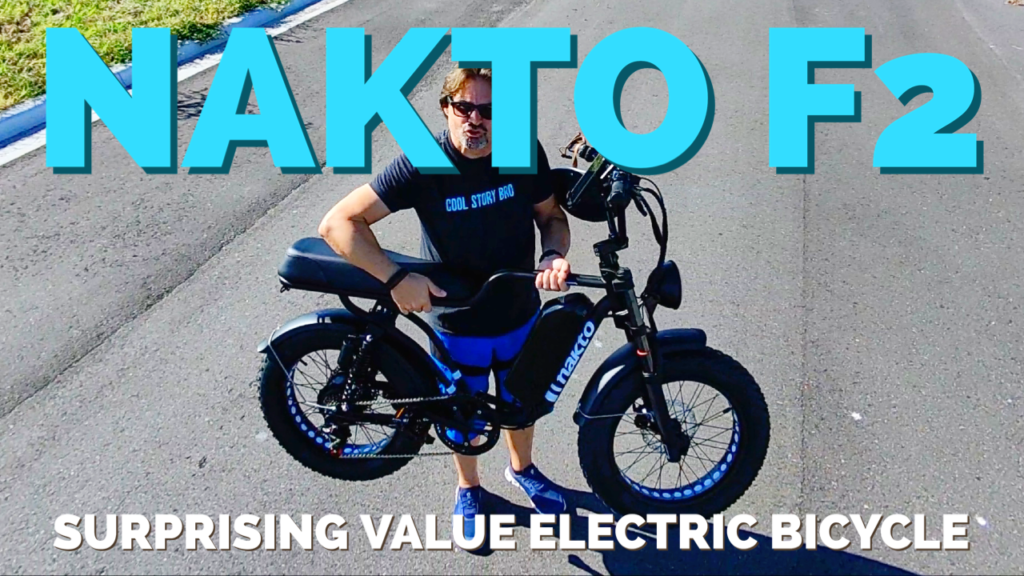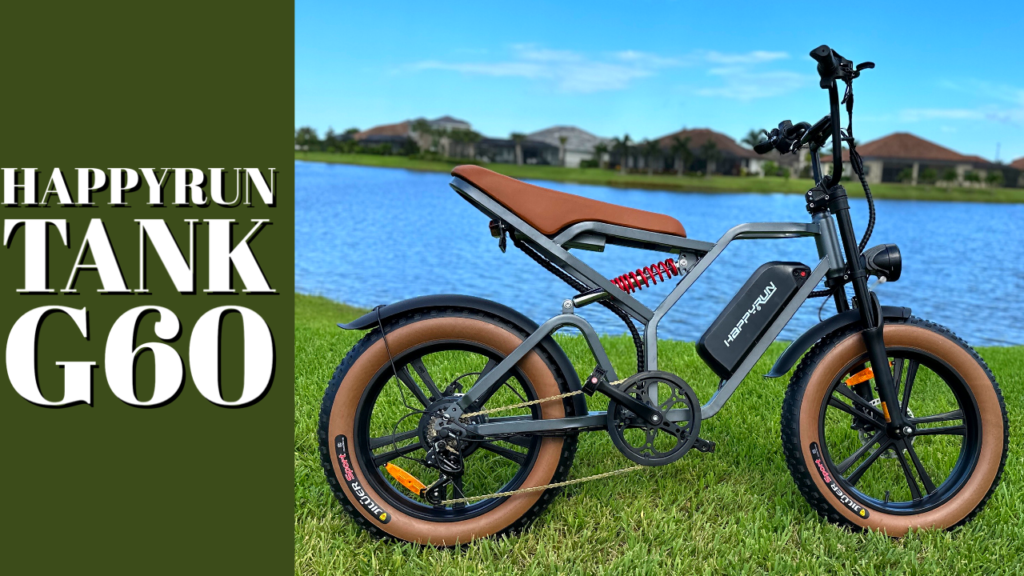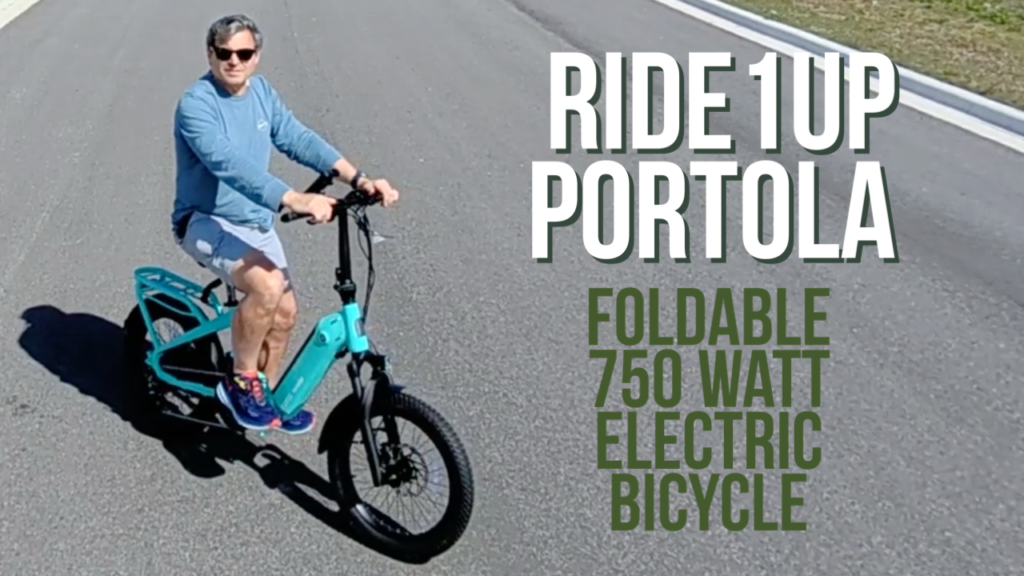When choosing an electric bike, the most important factor is to choose the right one for your needs made by a reputable company. We field a ton of questions about buying electric bicycles, so we created the Electric Bicycle Buying Guide to help address some of the more common concerns.
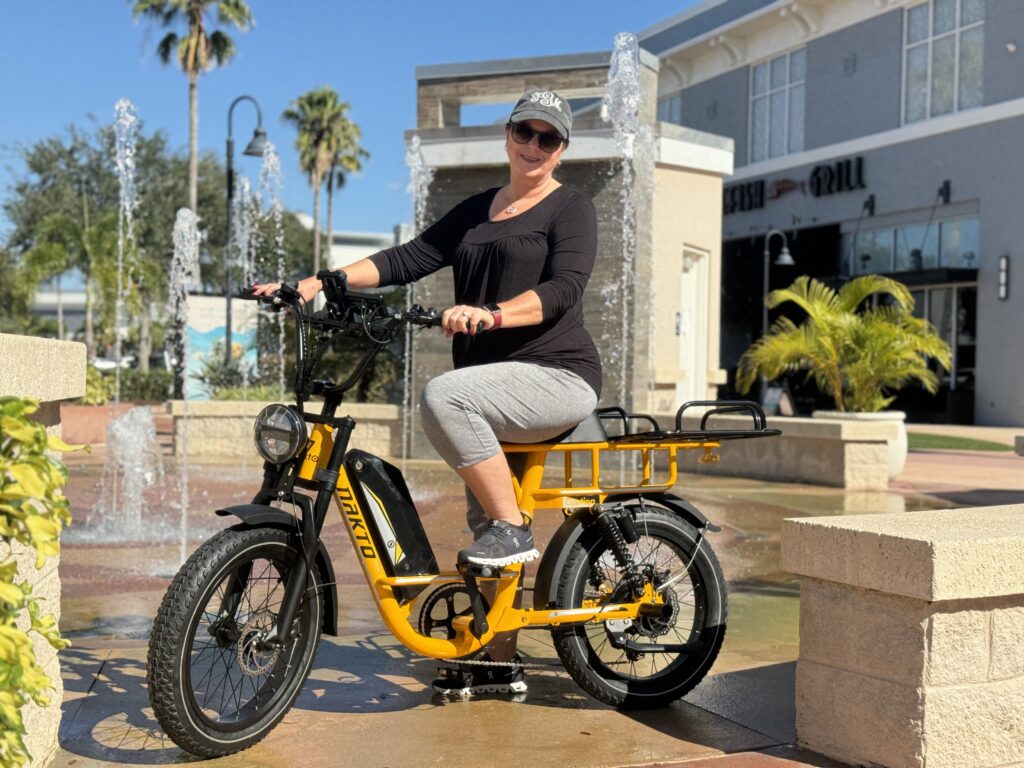
Types of electric bicycles
There are several kinds of electric bicycles. How you plan to ride, where you want to ride, and your travel plans are all important considerations when choosing the type of electric bike you want. Once you nail down this important decision, you can then move on to component considerations.
- Electric cruiser or commuter bicycles: These bikes are designed for everyday commuting in cities and more urban areas. They typically have thinner wheels and tires, plus smaller motors from 250-500 Watts. Most are lighter weight, which makes it easier to carry up stairs or lift on to bus bike racks. They may include features like fenders and racks to make your commute more comfortable, or those features may be sacrificed to save weight. Commuter bicycles won’t work well on grass, dirt, or rough terrain because of their thin tires and smaller motors.
- Electric cargo capable bikes: These bikes are designed to carry things like packages, groceries, food deliveries, tools, work equipment, or even pets and children. They tend to have fatter tires, thicker and heavier frames, more powerful motors from 750-1500 Watts, and often sport large baskets or racks to accommodate the stuff you’re carrying.
- Electric mountain bikes: These bikes tout features that are designed for off-road riding. In the American age of SUVs, they’re kind of the in-thing now, and can be ridden anywhere. People just like their bikes to look beefy. Plus, the fat tires do provide a more stable and softer ride. Real electric mountain bikes should have powerful motors with at least 750 Watts to provide sufficient torque to navigate loose dirt and sand. We’ve tested hybrid models with 500 Watt motors on the beach, and they seem to just get stuck. Most electric mountain bikes offer at least front suspension, while others offer dual suspension systems to handle rough or rocky terrain.
- Electric folding bikes: These bikes are designed for portability and convenience. They can be folded up quickly and easily, making them ideal for storing in small spaces, or for people who like to travel in RVs. We like to toss two foldable electric bikes into the back of our SUV to travel to places we can’t really bike to, like our local beaches that allow bicycle riding. Ironically, since these bikes are considered “portable,” most foldable electric bicycles have fat wheels, tires, and larger motors, just like electric mountain bikes. This increases their weight dramatically. Trying to lift an 80-100 pound foldable bike two to three feet into the air to get it into the back of an SUV is no picnic.
- Hybrids: Many electric bicycle manufacturers are blurring the lines between the types or e-bikes they offer. Today, it’s not uncommon to find a folding, electric mountain bike with space for cargo. We actually own one!
Local Laws, Regulations, and Electric Bicycle Classes
There are three classes are defined as follows.
- Class 1: eBikes that are pedal-assist only, with no throttle, and have a maximum assisted speed of 20 mph. Some states treat Class 1 eBikes like traditional mountain or pavement bicycles, and are typically legally allowed anywhere bicycles are permitted, including bike lanes, roads, multiuse trails and bike-only paths.
- Class 2: eBikes that also have a maximum speed of 20 mph using pedal assist, Class 2 bikes may be throttle-assisted. In most states, like Class 1 bikes, Class 2 throttle-assist eBikes are usually allowed most places a traditional bicycle can go. With more accidents occurring with children on electric bicycles, concerned parents are lobbying for additional restrictions. Class 2 electric bicycles may be prohibited from some mountain bike trails. Opponents claim throttle power can damage trails when the a full-throttle rear wheel creates deep grooves in the surface.
- Class 3: eBikes that are pedal-assist only, with no throttle, and a maximum assisted speed of 28 mph. Class 3 eBikes are typically allowed on roads and in bike lanes, but are sometimes restricted from bike trails and multi use paths. While a 20-mph maximum speed is achievable on a traditional bicycle, decision makers and agencies consider the greater speed of a Class 3 eBike to be potentially dangerous to other riders on some bike paths and trails.
All three classes limit a motor’s power to 1 horsepower, or about 750 Watts.
Now here’s where it gets sketchy. Many newer electric bicycles that are sold as Class 3 will also allow a throttle that will allow acceleration up to or sometimes exceeding 28 mph. A Class 4 distinction of e-bikes is emerging. These e-bikes go beyond the capabilities of Class 3 and have a maximum speed over 28mph and a power output of over 750 watts. These e-bikes blur the lines between bicycles and electric mopeds or motorbikes.
And… I’m probably not supposed to mention this, but many electric bicycle controllers can be hacked or reprogrammed to exceed the top recommended speed limit. Google is your friend.
Electric Bicycle Motors
E-bike motors come in three flavors: front hub, rear hub, or mid-drive. A lot of electric bike purists claim Bosch mid-drive motors are the most powerful and efficient, but they are expensive. Rear-hub motors are a powerful yet affordable option. Front-hub motors are the least expensive and the least powerful.
Mid-drive Motor: Efficient Power Distribution
The mid-drive motor is a popular choice among ebike enthusiasts for its efficient power distribution. Unlike hub motors, which are built into the wheels, the mid-drive motor is placed near the bike’s bottom bracket where the pedal crank is located. This placement allows the motor to better sense your pedaling action, and is supposed to result in improved overall efficiency. Mid-drive motors are suited for those who actually pedal and need a little assistance when tackling hilly terrain or super long rides. They seem to offer a natural riding feel and provide torque where you need it most.
Rear-hub Motor: Stealthier Appearance
A rear-hub motor is housed within the rear wheel hub. It is connected to the frame with a strong axle that pushes your electric bicycle, similar to rear wheel drive in a car. Since the motor is sort of hidden in the rear wheel, it’s a little less conspicuous compared to mid-drive motors. That’s only important if you don’t want others to chastise you for zipping past people without pedaling.
Rear-hub motors won’t have the efficient power distribution you’ll find in mid-drive motors. They’re more like scooter motors, with adjustments built in for pedaling. These motors typically have more torque for handling loose dirt and sand. And more torque provides faster acceleration. You can tell how much torque a bike motor has by the amount of jerk it provides when you engage pedal assist or throttle. It’ll often catch you by surprise.
The industry leader in rear hub motors is a Chinese company called Bafang. They offer ample instructions and supplies for repairs, which makes bicycle repair folks happy. And with their scale in manufacturing, they can offer the best motor prices in the industry.
Front-hub Motors
Front-hub motors are situated in the front wheel hub. They don’t interfere with your bike’s existing chain and gears, making maintenance and repairs a little more simple. To be honest, front-hub motors are extremely rare, and not commonly found at electric bicycle stores or offered by most popular electric bike manufacturers.
Popular Electric Bicycle Motor Manufacturers
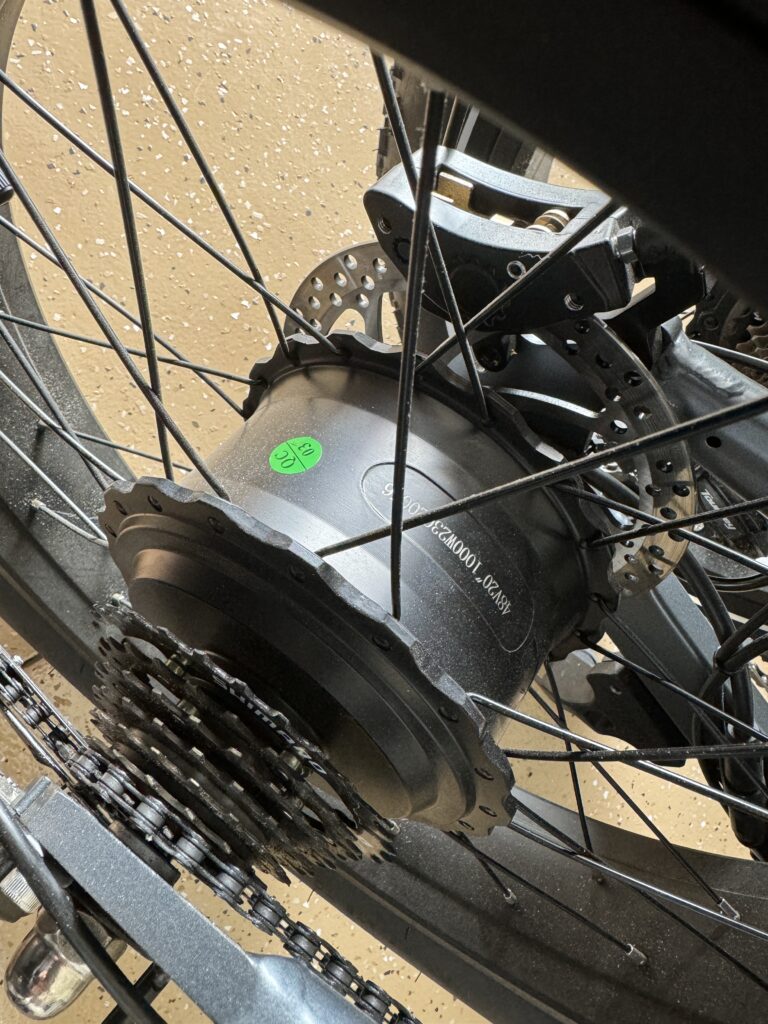
Bafang rear-hub motors are found in most popular ebike brands. They’re known for high power output, making them a great choice for off-road biking in loose terrain, or for people who are more concerned with speed than off-road performance. They’re fairly quiet, making that famous electric whirring sound you’re hearing everywhere. A Bafang rear-hub motor will typically use more energy, resulting in slightly lower overall ranges per battery charge. Reliability-wise, we’ve met people who have banked well over 2,000 miles on their Bafang motors, and others who have had issues since day one. Fortunately, most electric bike mechanics are familiar with repairing Bafang motors, and parts are easy to come by.
Bosch mid-drive motors are usually quieter, and and have a smoother power delivery. The Bosch motor seem to be more suitable for flat urban commutes. They’re also two to three times the cost of most rear-hub motors. These are recognized as extremely reliable, but things can happen. Repairing a Bosch is a little more involved and expensive.
Some people claim that Yamaha motors are even better than Bosch. There are also motors made by Shimano and other companies, but they’re not as popular.
Torque vs Cadence Sensors in Pedal Assist Systems
In order for the ebike’s motor to engage, a signal is sent from the pedal assist once the pedals start cranking. The component that relays this signal is called a sensor. Electric bikes are generally equipped with either one of two ebike sensor types: a cadence or torque sensor.
Torque sensors, commonly found in mid-drive motors, utilize a strain gauge to measure how hard the rider is pedaling. Any pedaling triggers the motor to activate as soon as the rider puts pressure on the pedals, but the motor’s power is determined by the effort in your pedaling. Since torque sensors have lower latency, they make these adjustments in real-time, increasing or decreasing the motor’s output depending on the amount of pedal force a rider applies. Some people remark that torque sensors give them more control over how fast or slow they want to go.
Cadence sensors measures if a rider is pedaling at all. This sensor doesn’t care how hard you’re pedaling. Cadence-based pedal assist systems engage an electric bike’s motor when a rider begins to pedal while PAS is turned on. The motor then provides a pre-determined amount of power to move the rider forward. Riders feel that cadence sensors are more like a moped, where a little effort will get you a sharp jerk or boost of power. These are commonly found on electric bikes that have rear hub motors.
Electric Bicycle Battery Considerations
The battery that comes with your electric bicycle is another important factor to consider. E-bike batteries come in a variety of sizes and capacities, so it’s important to choose one that will give you the range you need.
Basically, all electric bicycle batteries used in today’s bikes are packs of several rechargeable AA-sized lithium-ion batteries wired and taped together inside a plastic enclosure. This is very similar to the technology used in smartphone batteries. The total number of cells determines the power capacity or longevity of the bike battery. In normal circumstances within the recommended temperature and humidity, rechargeable lithium-ion cells have the ability to be charged hundreds of times before losing their capacity to hold a full charge.
There is a range of battery options, each with its own unique specifications. A 36V 10A battery is common on smaller bikes where a lot of power is not needed or prohibited by local laws or regulations. Most electric bicycles sold in America offer 48V battery options, with Amperage anywhere from 8A to 20A. The higher the voltage and amperage, the more energy the battery can store, resulting in increased range, longer rides, faster rides, and more torque. Your choice of battery depends on your specific riding needs and preferences, whether you’re looking for a casual cruise or a more demanding adventure.
Many electric bike manufacturers will offer a battery measurement called Watt hours. This is obtained by multiplying Volts times Amps, and will give you a benchmark measurement that will help riders gauge how long a battery will last at a given rate of power. For example, a 48 Volt 16 Amp battery results in 48 x 16 = 768 Watt hours. Oversimplified, this means if you have a 750 Watt motor and you’re running it full throttle using the full 750 Watts, you can expect your battery to last just over one hour before the charge is depleted. In that one hour and a few minutes, you probably traveled between 25-40 miles, even if you didn’t pedal at all.
Of course, these are bicycles, and you should help out and pedal for exercise, and to help your battery last a little longer. However, some folks can’t pedal due to physical limitations, and that’s completely fine. As long as your destination is accessible within a full battery charge, and you have 4-6 hours for a full recharge while at your destination, this situation will probably work for you.

This electric bicycle buying guide wouldn’t be complete without this warning. There have been reports of electric scooter and electric bike batteries catching fire after they’re damaged, overcharged, or even extremely undercharged. These reports are completely true. However, with millions of these electric bicycles now scattered around the world, those battery fires are statistically rare. Right now, I have ten electric bicycles sitting in my garage, and I sleep like a baby. I am completely aware that anything can happen, and you should be prepared for this situation just in case.
Here are some helpful tips to ensure you remain as safe and secure as possible.
- Ensure your battery has reliable cells produced by a reputable company. We see a lot of Samsung or LG cells in electric bicycles because they’re extremely reliable. Large manufacturers are more apt to comply with established safety standards, so there’s accountability. Smaller companies may cut safety corners to lower costs. If you’re not sure which cells are in your battery, ask your retailer.
- If you’re storing lithium batteries for a long time, try to store them in the “Goldilocks Zone” between a 40 and 70% charge. it’s extremely difficult to know the exact charge on any electric bike battery, but if you guesstimate the midpoint, you’ll probably be fine. Never store them fully charged, or anywhere close to depleted, since these are common situations in which poorly manufactured batteries can become unstable.
- Make sure you store electric bike batteries at room temperature, typically well above freezing and well under any temperature humans consider too hot for survival. In the coldest winter months, you may want to bring at least the battery indoors.
- Although it’s extremely rare, try to store your electric bike battery in a place that’s close to a window or an unused outside door, so in the event of a fire, you can ventilate some of the toxic fumes outdoors. Make sure not to block your own exit pathway just in case.
- Store your electric bicycle battery somewhere that’s not conveniently close to any combustable or flammable items, like paper, wood, or gasoline cans.
- I store my unused electric bicycle batteries in a wide, uncovered steel trash bin that’s not close to anything flammable. Steel has a high melting point, and most flames will raise straight up after they reach their limit going sideways inside the bin. With 11′ high celings, although I must admit it’s possible, it’s unlikely a flame would go high enough for long enough to result in a house fire. Also, in the event of a small explosion, much of the shrapnel will be contained inside the can.
Other Electric Bicycle Features You Should Know
Other important features to consider include brakes, gears, tires, and suspension. It’s also important to make sure that the e-bike you choose is the right size and fit for you. Some have adjustable seat heights, and others are more like small motorcycles where the seat hight is not adjustable. Besides the motor and battery, several other features and components can significantly impact your ebike experience:
Do you want a single speed, or a 5, 6, 7, or 8 speed gear system? When you’re actually pedaling, it’s nice to have different gears for different situations. First gear is the easiest to pedal, useful for starting out from a dead stop. The highest gear is used once you’ve achieved some good speed. It’s important to know the gears really have nothing to do with your motor, they’re only used for pedaling. There is no gear shifting involved with any electric motor.
Do you prefer a thumb throttle, or a half-twist throttle? Thumb throttles are little spring-loaded levers on the left or right side of your handlebars. When pressed, these tell the engine to supply power to your electric bike. A half-twist throttle is almost always on the right side, and functions like a typical motorcycle throttle. You twist it to apply power from your motor.
Foofy snob purists prefer hydraulic brakes. They tend to be smoother than mechanical brakes. They do require some maintenance and are a little more difficult to adjust. To be completely honest, they both work equally as well at stopping your bike, even at 28 mph.
Dual suspension is great if you plan to ride rocky or bumpy trails, or if you just prefer a softer ride in a more urban environment. Most moderately priced electric bicycles come with front fork suspension standard. Upgraded versions will have the front fork and either a rear fork or mid-frame shock absorber. We have also seen seat posts with springs in them to provide a more affordable dual suspension.
If you plan to ride at night, make sure you have front and rear lights. Most affordable packages come with headlights, but tail lights may not be included, or can be an additional cost. It’s better if your bike comes with a tail light pre-wired into your bike’s battery harness. This way, you won’t have to worry about replacing batteries or forgetting to flip an extra switch.
If you want to carry pets, children, or packages, many electric bikes offer custom racks or basket solutions. Not all racks will fit all bikes, so make sure you buy something compatible with your bike.
The Best Brands of Electric Bicycles
We have tested ten different brands of electric bicycles, and learned a lot over the past three years. When shopping for an electric bicycle brand or manufacturer, it is important to consider the following things.
- Latest technology: Ensure your chosen brand follows technology trends and integrates the latest innovations into their e-bikes. This may include improved motors, more accurate sensors and controllers, safety innovations, and longer lasting battery technology. The latest tech will cost a little more than outdated tech, so be prepared to pay a few extra dollars for the improvements.
- Trustworthy brand: Check the ratings and reviews of each company. Chances are you probably won’t need customer support, but things happen when products are shipped halfway across the world. Although it’s extremely difficult to return such a large item, most reputable companies will attempt to make any unfortunate situation right. Since many of the vendors are Chinese, keep in mind there may be a language barrier when communicating your problems, and there’s also a 12 hour time difference. When it’s 2 PM on the East Coast, it’s likely 2 AM in China.
- Well known and recognized components: Check what company makes the motor on your electric bicycle. Bafang is a Chinese company and is probably the most popular right rear-hub motor vendor now. They’ve been around since 2003, so there is a track record of success. Shengyi is a distant second, but also provides rear-hub motors for some large e-bike vendors. Bosch is the most expensive, and produces popular mid-drive motors. Regarding batteries, as long as there are Samsung or LG cells in the battery pack, you’re probably safe. Shimano is still the industry leader for derailleurs, with SRAM and Campagnolo as worthy alternatives. Tektro and Magura make popular mechanical and hydraulic disc brakes.
Try not to get all weird about things made in Asia. Just about everything is made in Asian nations today, and most of it is just as good as anything made anywhere else in the world. Due to lower labor costs in Asian nations, the products you love are more affordable.
We’re also affiliated with several electric bicycle brands we’ve tested on our YouTube channel. Watch the reviews to see the features of each model. If you choose to buy one, please use our sponsored links in the description of our YouTube videos, or below, and we may earn a small commission from your purchase. Don’t worry – your price won’t increase. As a matter of fact, our links may save you a few dollars!
- NAKTO: Use discount code FRESH60 for $60 OFF your order https://nakto.com/
- WALLKE: https://wallkeebike.com?aff=78
- ENGWE: https://shareasale.com/r.cfm?b=2286723&u=3156491&m=111433&urllink=&afftrack=
- MOKWHEEL: https://www.mokwheel.com/?aff=2
- KBO: https://kbobike.com?sca_ref=1537177.y9J9utE8rJ
- HEYBIKE: https://www.heybike.com/products/heybike-mars-electric-bike?ref=freshandfelicia&utm_medium=goaffpro&utm_source=affiliate
- JASION: https://www.jasionride.com/?ref=34uw948hg0
- MAGICYCLE: https://www.shareasale.com/u.cfm?d=875235&m=111475&u=3156491
- WTVA: https://wtvabikes.com/?ref=34uw948hg0
- RIDE1UP: https://ride1up.com/product/core-5/?wpam_id=760
Frequently Asked Questions about Electric Bicycles
Here are some of the most common questions that often arise when it comes to purchasing an electric bike. Do you have a question? Add it to the comments below. We all can share and learn.
1. What’s the Range of an Electric Bike?
The range of an electric bike can vary significantly depending on factors like the battery capacity, motor efficiency, and riding conditions. Generally, most electric bikes offer a range of 20 to 50 miles on a single charge. Some high-capacity models, or bikes with two batteries, can even exceed 100 miles of range. It’s important to consider your daily commute or riding needs when assessing battery capacity.
2. How Long Does It Take to Charge the Battery?
Charging times differ among batteries. Standard chargers usually take 4 to 6 hours to fully charge the battery. Some fast chargers can reduce this time to around 2 to 3 hours. Keep in mind that it’s essential to follow the manufacturer’s recommendations for charging to prolong the battery’s lifespan.
3. Do I Need a Special License to Ride an Electric Bike?
In most places, you don’t need a special license to ride an electric bike. As we previously learned, most are classified as bicycles, provided they meet certain criteria like a maximum speed limit of 20 mph (32 km/h). However, regulations can vary between local municipalities, so it’s essential to check your local laws to ensure compliance. We understand England is particularly harsh with enforcing electric bike rules, while most of Florida lets you do whatever you want.
4. Can I Ride an Electric Bike in Inclement Weather?
Most electric bikes are designed to handle various weather conditions. However, it’s crucial to take precautions and protect the electronic components like your display and controller from exceptionally heavy rain. Water-resistant accessories can be added to improve weather resistance. Or, you can rig things yourself with sandwich bags and painters tape. We’ve done worse. Just don’t make the mistake of riding in deep water.
5. How Do I Maintain an Electric Bike?
Maintaining an electric bike is relatively straightforward. Regularly check the tire pressure, keep the chain lubricated, and inspect the brakes. Charge the battery when necessary. If you’re storing your bike without riding for a while, try to keep it in a cool, dry place with the battery at about half charge.
6. How Much Do Electric Bicycles Cost?
We have seen electric bikes with smaller 36V batteries and 250W motors at Costco for under $500. A name-brand mid-drive with all the bells and whistles can run well over $5,000. Most of the more popular brands like Nakto, Heybike, Engwe, and WTVA range from as low as $800 to $1500 for a 500 to 750W motor and a battery with generous capacity.
7. What About Warranties for Online Bikes?
Check the warranty period before you buy. Things happen no matter what company you choose, and yes, even the “American e-bike companies” that are really front-ends to Chinese manufacturing. Most reputable companies offer a two-year warranty on parts only. Labor is typically on you simply because of logistics. It’s a little hard to get a bike to a service center in China and back. E-bikes typically make a one-way trip. That’s the advantage of spending a little more and working with a local brick and mortar store.
If you’re handy and can replace parts yourself, you won’t have to worry about local service. Some of these parts including the motor can be very intricate and may need to be completely disassembled. Oh yeah, I’ve heard some stories. So make sure there’s a qualified or authorized local e-bike service center or person in your area. For a myriad of reasons, many old-school bicycle shops won’t work on e-bikes they don’t sell, so don’t assume they will.
If you end up ordering online, that’s cool too. There are some really good deals online. But do your homework, and find one of these resellers who has been around a few years, has a good reputation, and a proven customer service track record. A few companies have phone numbers that ring in China, and there’s a huge language barrier. Look for someone who has North American support just in case something goes wrong. There are a ton of horror stories on social media, yes, even from the supposed “American” e-bike companies, so join some of the groups and do your homework.
8. Will I need insurance for my electric bicycle?
E-bikes are expensive, and there’s a high theft rate. So keep in mind you’ll need to store your e-bikes somewhere dry and secure. Chaining it up to your front gate won’t keep a dude with bolt cutters or a cordless drill from quickly popping your thousand dollar investment into his old pickup. It happens. Keep it in a garage, or indoors if you have an apartment. I have two chains and a loud motion sensor alarm on one of my e-bikes just for laughs.
Here’s the thing. E-bikes are still kind of a new thing. But all it takes is one idiot 20-something with a 1500 watt e-bike going way too fast on bike path who mows down a first grader and everything hits the fan. E-bikes are faster, so they’re harder to stop. There’s more chance of injury to you, and potentially someone else. Insurance underwriters won’t spend the time to look at something until they have to, and you really don’t want to be a guinea pig in a room filled with lawyers working against you.
An e-bike traveling 20-28 miles per hour assumes many of the same risks as motorcycles. We’re talking loose gravel. Potholes. Deer. So you’re probably going to need two types of insurance.
9. Won’t My Homeowner’s Policy Cover My Electric Bike?
I pulled out my homeowners policy – under contents coverage… property not covered includes “any engine or motor propelled vehicle or machine, including the parts, designed for movement on land”. Coverage only extends if the vehicle or machine is used solely to service the property or assist a disabled person. So any motorized vehicle that’s not a wheelchair or lawnmower is not covered, and may be considered a moped or motorcycle. So if it’s stolen or damaged, sorry, it’s not covered.
In some states and in some policies, a Class 1 E-Bike with pedal assist only is still considered “just a bike” and is covered, even though the motor has a max of 22 mph like the Class 2. Remember, the difference is there’s no throttle.
Then there’s that liability monster. If a kid or dog runs out in front of my throttle bike, I probably have zero liability insurance coverage under my homeowners or auto policies and could be liable for damages of tens of thousands or even more. Since e-bikes are still so new, the current catch-all solution is to purchase motorcycle coverage for liability. If you want to be covered for theft, damage, medical, uninsured motorist or underinsured motorist, that would probably be additional. Rules do vary widely from state-to-state and even carrier-to-carrier, so check with your state and agent, and protect yourself – don’t ever accept a vague answer. Make him earn his commission.
10. How Much Do Electric Bicycles Weigh?
Most electric bikes are heavy. Two of mine with 750 Watt motors are over 80 pounds each, and my latest dual battery model weighs in at 102 pounds. Sooner or later, you’ll probably need to lift that thing somewheres. If you want to hang your bike on a wall rack or on the back of a car or truck, standard bike racks are probably too weak to hold an e-bike safely. Check the weight limits of your rack. Most Class 2 and Class 3 e-bikes weigh somewhere between 50-70 pounds. There are some Class 1 models with smaller motors and batteries that weigh in at 35 pounds that will fit on most bike racks, and are easier to carry up stairs if you ever need to do that. I have a 35 pound Class 1 e-bike I keep in a closet just because I can.
11. Are Electric Bicycles Too Big For Me?
Some of the 26″ electric mountain bike models are quite big, so people under 6 feet tall may have a problem riding some of these comfortably. Fortunately, there are several sizes to choose from, from 20” wheels all the way up to 29” wheels. The most common wheel sizes are 20 and 26 inches. If you’re less than 5’9”, a 20” e-bike is probably your best bet. Make sure the seat height is adjustable – some of the smaller cargo or mountain bikes have fixed seat heights that might end up being too high. Take a test ride at a local dealer if that’s an option.
12. Step-Thru or Fixed Bar
And then there’s the step thru vs non step through option. Step-thrus lose that annoying bar you have to step over. They used to call step-thrus ‘girl bikes” because women used to have to wear dresses when riding bicycles in the old world. True story. Today, it doesn’t really matter. People who do deliveries and older folks like me who just don’t wanna kick our legs up that high anymore ride step thrus. There’s no difference functionally between a step through or a bike with a cross bar.

